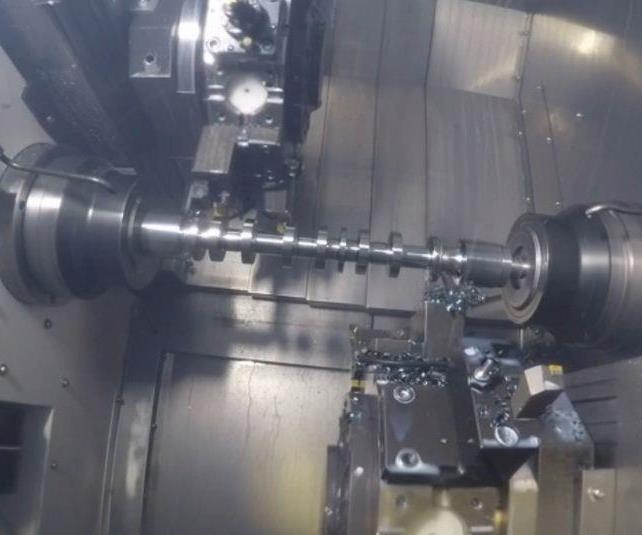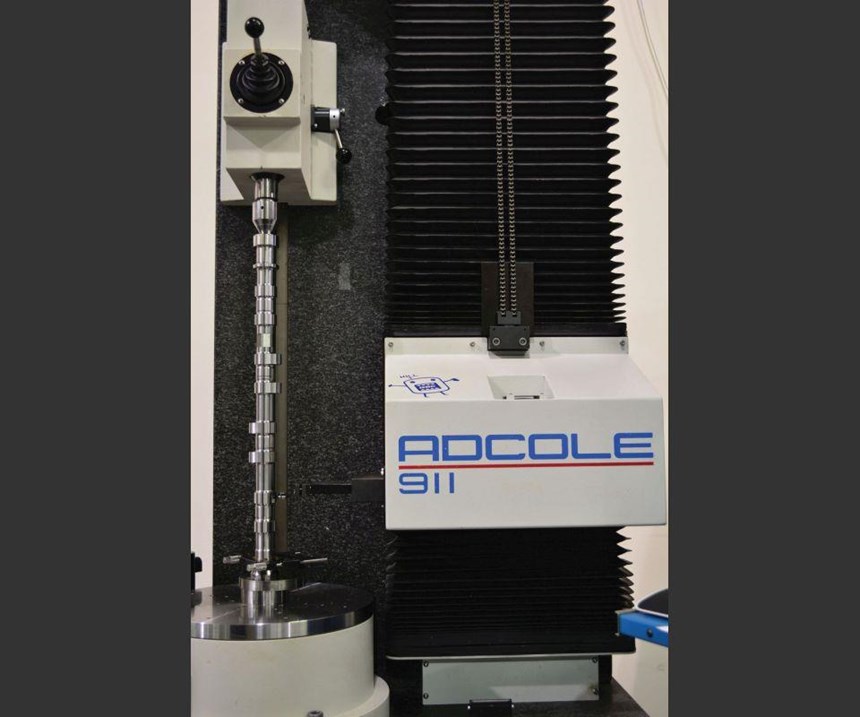CAM Software Helps Company Reshore Camshaft Production
Edgecam by Vero Software eliminated long lead tiems for GSC Power Division's outsourced parts by enabling in-house production at higher speeds and qualities.
Share






Takumi USA
Featured Content
View More


.png;maxWidth=45)
DMG MORI - Cincinnati
Featured Content
View More
Autodesk, Inc.
Featured Content
View MoreWaiting a year or more for outsourced parts was not acceptable for Greg Caloudas, owner of GSC Power Division, a producer of performance-vehicle camshafts and valve-train components located in Landson, South Carolina. Taking matters into his own hands, Mr. Caloudas acquired what he thought would be the machinery and software necessary to bring camshaft production in house. When the CAM software he initially chose underperformed on the shop floor, he switched to Edgecam by Vero Software (Forest Lake, Minnesota) and was able to meet production goals.
Mr. Caloudas began making precision parts for European and Japanese sport compact cars in 2005 and has since created his own brand of products sold to precision-performance automotive shops. Yet the business could not grow as he wanted it to because he had to wait 12 to 15 months for camshaft castings produced by international foundries. “Our customers were not happy with lead times, and we wanted to eliminate relying on others for any specific operation for camshafts,” he says. “I also wanted to produce a product that was designed for the levels of performance my customers were achieving in their engine setups rather than using a similar OEM-cast camshaft core.”
In late 2013, Mr. Caloudas decided to move all elements of camshaft production in house by acquiring a new Hyundai Wia LM1800 TTSY twin-turret lathe with live tooling from Adept Machine Tool and an Okuma vertical mill with a four-axis rotary. He also began searching for a CAM solution that could help him manufacture 50 parts per shift—a number much higher than the six to 10 parts other machine tool manufacturers told him to expect. He ultimately chose Edgecam specifically for its advanced milling and turning capabilities. Along with a highly specialized grinder used to shape camshaft lobes, Mr. Caloudas believed he now had all the tools necessary to generate greater customer satisfaction.
His production method involved streamlining operations and maximizing machine capabilities. For instance, using a turning center to reduce a 35-pound steel bar to 10 pounds in as short a time as possible, he utilized Edgecam’s Waveform roughing strategy. The high-speed machining technique maintains a constant cutting load by ensuring that the tool remains consistently engaged in the material throughout the operation. This optimizes feed rate throughout the cycle, improving tool life and reducing tool breakage. Also, because the tool path moves smoothly, sharp changes in direction are avoided and consistent machine tool velocity is maintained.
To machine camshafts, GSC Power Division uses a full-radius groove tool, and the programmer determines the amount of tool contact. The bar of material is also synced to connect to the lathe’s main spindle and subspindle. Waveform is used on the top and bottom turrets for two tools, and the camshaft is processed by machining different sections of the cam.
“The Waveform turning cycle cuts the entire cutting time in half,” Mr. Caloudas says. When he first started, he used balance-turning with the upper and lower turrets, which took about 21 minutes per cycle. Using Waveform, the same operation can be turned in about nine minutes. “The software has really helped us make the process quicker, along with stepping up the tooling package that we run,” he says.
The shop also takes advantage of Edgecam’s knowledge-based Strategy Manager, which enables programmers to easily create repeated processes that can be used to save time on repetitive tasks while maintaining and saving best practices. At its heart is a simple, user-friendly graphical flowchart that helps the programmers create flexible strategies for machining solid models. Without imposing rules or working methods, Strategy Manager empowers programmers to fully and consistently utilize their own knowledge, Vero says.
Mr. Caloudas created a strategy in Edgecam for his precision drill and ream process, which entails drilling a hole and boring to “true it,” followed by drilling 15 to 20 times the diameter of the hole and, finally, reaming the hole.
He also utilizes Edgecam’s advanced five-axis milling capabilities and cycles to prepare his camshafts for the grinder, where they take on their final shape. Edgecam offers an extensive suite of advanced milling cycles that are geared toward rapid toolpath generation and control, as well as reduced cycle times and greater overall efficiency.
When a camshaft ultimately makes its way to the grinder, a chamfer has to be cut on each end to center the part. This is typically performed as a separate operation, but Mr. Caloudas completes it with the single turning operation. “We process the bar on one end, then with the bar synced between two spindles, and then we do the back side of the bar, all in one program,” he says. “It’s a four-part process that would not be very efficient if I had to go through it every time,” he explains. “It involves different sized drills and the selection of appropriate tooling, which takes time.” Mr. Caloudas and his Edgecam reseller, Steve Harrison of Silverhawk Solutions, created a strategy for the process that drastically cuts programming time.
GSC Power Division’s camshafts feature lobes that are ultimately shaped with the company’s precision Shigiya CNC lobe grinder, but material must first be removed on and around the future lobes with the mill. The biggest bottleneck in the past was removing stock from the blanks, which took almost four minutes. Now, it only takes 2.5 minutes to mill and grind the lobes. Using advanced milling cycles, the company can remove the material in 50 seconds per lobe, sending parts to the grinder with less material to be removed. For instance, when GSC Power Division used castings to make the camshafts, 4 to 5 mm of material had to be removed. With the addition of Edgecam, only 1 to 2 mm must be removed.
Today, Mr. Caloudas is turning out not only more parts quicker than ever before, but also parts of higher quality. The company is no longer subject to timetables imposed by foundries, and his customers are happier than ever before. “We are now making camshaft blanks that are designed to withstand four to five times the output of the stock engine,” he says. “My customers push every aspect of a car’s performance, and they need parts that can take the abuse.”
Related Content
How this Job Shop Grew Capacity Without Expanding Footprint
This shop relies on digital solutions to grow their manufacturing business. With this approach, W.A. Pfeiffer has achieved seamless end-to-end connectivity, shorter lead times and increased throughput.
Read MoreCan ChatGPT Create Usable G-Code Programs?
Since its debut in late 2022, ChatGPT has been used in many situations, from writing stories to writing code, including G-code. But is it useful to shops? We asked a CAM expert for his thoughts.
Read MoreBringing Machining In-House to Keep up With Demand for Offroading Parts
To meet demand increases for its Ford offroad industry components, supplier RPG Offroad brought its machining processes in-house, saving the company nearly $50,000 per month. Here’s how its choice of integrated CAD/CAM software made it happen.
Read MoreOrthopedic Event Discusses Manufacturing Strategies
At the seminar, representatives from multiple companies discussed strategies for making orthopedic devices accurately and efficiently.
Read MoreRead Next
5 Rules of Thumb for Buying CNC Machine Tools
Use these tips to carefully plan your machine tool purchases and to avoid regretting your decision later.
Read MoreSetting Up the Building Blocks for a Digital Factory
Woodward Inc. spent over a year developing an API to connect machines to its digital factory. Caron Engineering’s MiConnect has cut most of this process while also granting the shop greater access to machine information.
Read MoreBuilding Out a Foundation for Student Machinists
Autodesk and Haas have teamed up to produce an introductory course for students that covers the basics of CAD, CAM and CNC while providing them with a portfolio part.
Read More













































